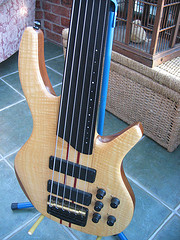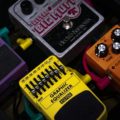In this article, we explore the history of the electric bass guitar Learning to Enjoy Bass Guitar - Do you enjoy bass guitar? A bass guitar is a four-stringed instrument that typically accompanies a lead guitar. Some bass guitars have additional strings, with 5 or 6 strings in total. Bass guitars produce lower tones, and an electric bass guitar is connected to an amplifier for enhanced sound. When learning to play the bass… . When discussing bass history, the first person that usually comes to mind is Leo Fender, who introduced the Precision bass in 1951. Named for its precise notes, the Precision bass had frets that allowed players to produce well-tuned notes. To many, this was the first true electric bass 5 String Bass Guitars - If you have experience playing a 4-string bass guitar, you might enjoy playing a 5string bass. The 5-string variety is becoming increasingly popular, as bass players seek a broader range of sounds without constantly moving up and down the fretboard. The rise of 5string bass guitars began in the late 1980s, coinciding with the emergence… , and it remains widely recognizable and mass-produced today.
However, before crediting Leo Fender for creating the modern electric bass, it is important to acknowledge that at least five different prototypes resembling today’s electric bass guitar Learn how to Enjoy Bass Guitar With These Opportunities - So you want to learn how to play bass guitar? That's fantastic. The key to learning bass guitar is to make the process as fun and enjoyable as possible. Luckily for you, there are several different methods to consider when learning how to play the bass guitar. You will need to carefully evaluate these approaches… existed before 1951. The history of the bass guitar is closely tied to the double bass Double Bass Bow - For those interested in playing the double bass, also known as the string bass, there are essential factors to consider before purchasing a bass bow. A bass bow is the instrument used to play the double bass, or the French bass. Before delving into the details of buying a bass bow, it is crucial to… , which dates back to the 17th century, although a more practical form was only developed in the 20th century.
Lloyd Loar, known for designing the first electric double bass in the 1920s while working for Gibson, played a significant role in bass guitar history. His bass utilized an electro-static pickup, but there was no practical way to hear it play, as bass amplification technology still needed improvement.
The evolution of the bass guitar continued in the early 1930s when Paul Tutmarc developed a more practical bass in terms of size. Initially designed with the size and shape of a cello, it was eventually modified to resemble a guitar. This 42-inch-long solid body bass was made from black walnut and featured piano strings and a pickup. By the mid-1930s, established companies like Lyon & Healy, Rickenbacker, and Gibson started selling basses that were less bulky than the traditional double bass but still tall, unfretted, and upright.
Around 1940, L.D. Heater Music Co. in Portland, Oregon, became the first large distributor to handle the electric bass, featuring basses made by Paul Tutmarc. This fretted instrument was designed to be played horizontally rather than upright, and included a pickup and a smaller size than previous models.
Leo Fender’s introduction of the modern electric bass in 1951 marked a turning point in bass guitar history. In 1957, the pickguard and headstock were redesigned, and the pickup was changed to a split pickup. The Jazz bass, which came with two separate pickups, was designed in 1960 and quickly gained popularity.
The first six-string bass was created by Danelecto in 1959, followed by Fender’s five-string bass in 1964. Ampeg built the first fretless bass in 1965, and Hagstroem introduced an eight-string bass in 1968. Carl Thompson is credited with building the first fretless six-string bass in 1978.
Numerous developments have occurred since then, such as Ned Steinberger’s introduction of a headless bass in 1979 and the Guild Guitar Corporation’s creation of the fretless Ashbory bass in 1987. This bass used silicone rubber strings and a piezoelectric pickup to achieve a “double bass” sound and was quite short at just 18 inches long.
Pickups have also evolved over the years, with various types available including single-coil pickups, humbuckers, hybrid pickups, and passive and active pickups, producing a wide range of tones from pure to gritty.
The electric bass has become more popular than ever before, to the extent that when someone refers to a bass, it is now more common to think of the electric bass rather than the upright acoustic.
Manuel Marino is a seasoned Senior Producer, Music Composer, and Artist with over a decade of experience. He specializes in branded entertainment across various mediums, including video games, films, and advertising campaigns. With 20+ years as a game music composer, Manuel has worked on numerous platforms, creating diverse orchestral soundtracks. HIRE ME


 Manuel is a passionate, driven, and techsavvy AV technician,
Manuel is a passionate, driven, and techsavvy AV technician, 










